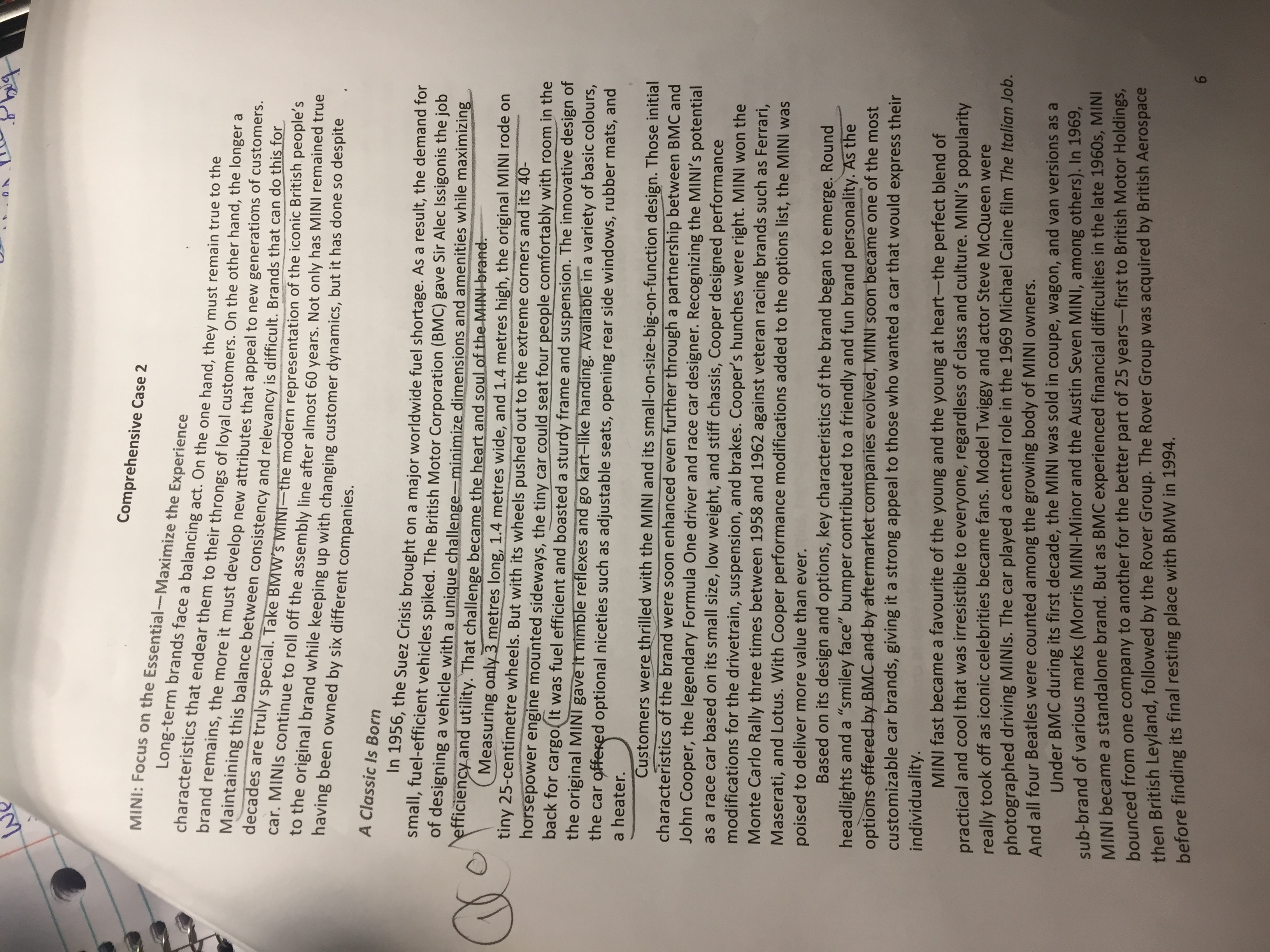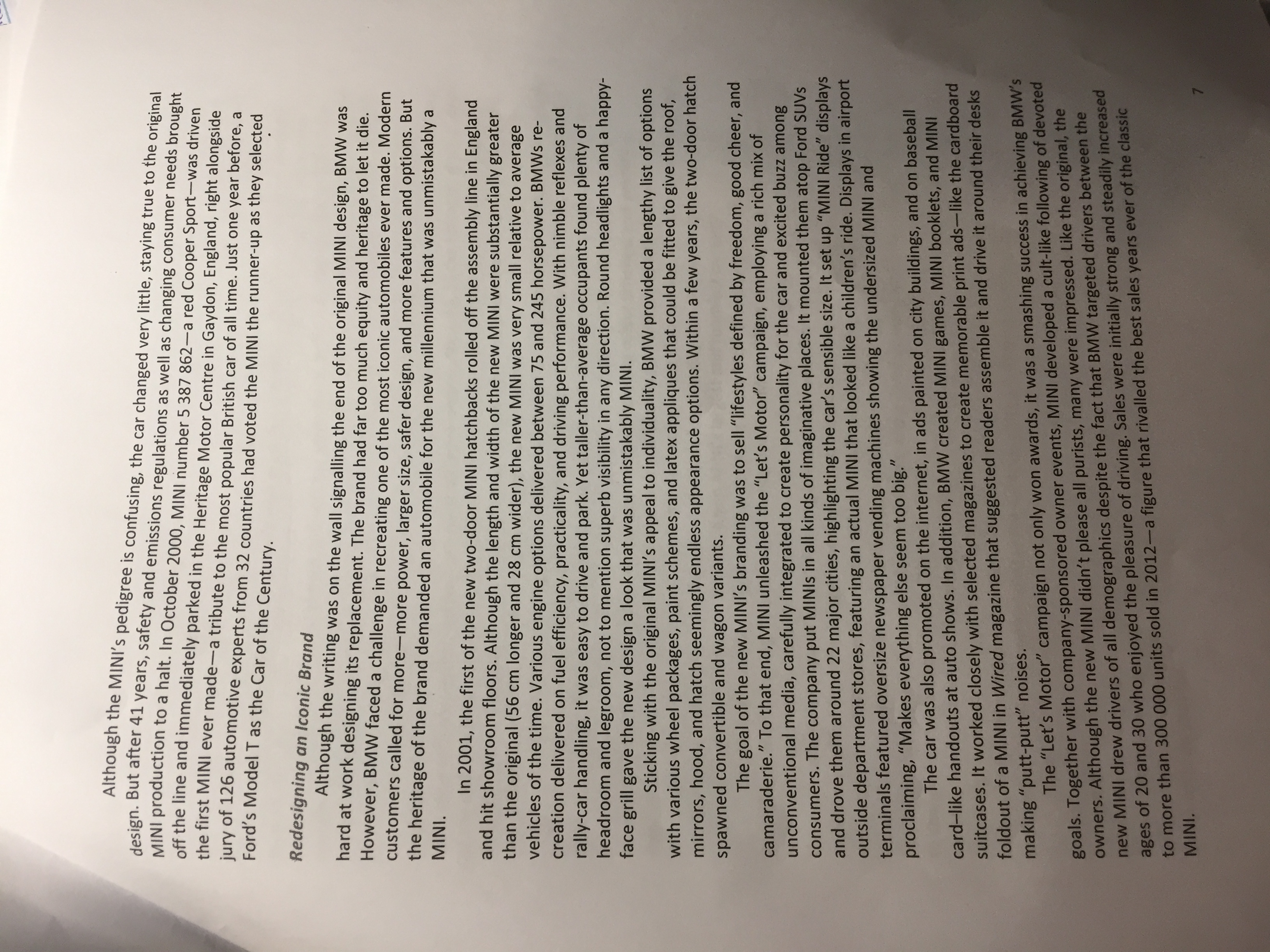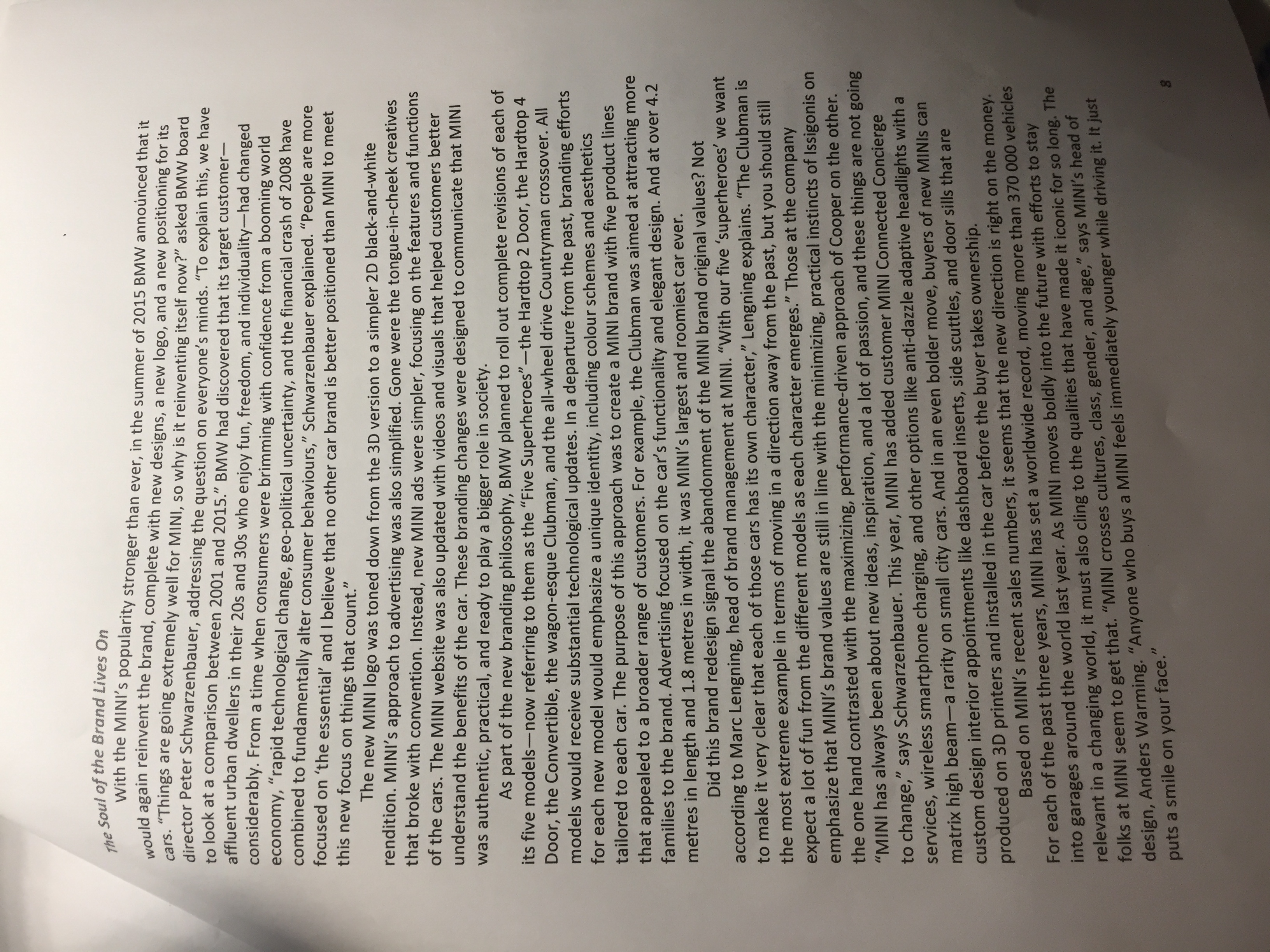please solve the c parts only of each question
bog Comprehensive Case 2 MINI: Focus on the Essential-Maximize the Experience Long-term brands face a balancing act. On the one hand, they must remain true to the characteristics that endear them to their throngs of loyal customers. On the other hand, the longer a brand remains, the more it must develop new attributes that appeal to new generations of customers. Maintaining this balance between consistency and relevancy is difficult. Brands that can do this for decades are truly special. Take BMW's MINI-the modern representation of the iconic British people's car. MINIs continue to roll off the assembly line after almost 60 years. Not only has MINI remained true to the original brand while keeping up with changing customer dynamics, but it has done so despite having been owned by six different companies. A Classic Is Born In 1956, the Suez Crisis brought on a major worldwide fuel shortage. As a result, the demand for small, fuel-efficient vehicles spiked. The British Motor Corporation (BMC) gave Sir Alec Issigonis the job C of designing a vehicle with a unique challenge-minimize dimensions and amenities while maximizing efficiency and utility. That challenge became the heart and soul of the MINI-brand. Measuring only 3 metres long, 1.4 metres wide, and 1.4 metres high, the original MINI rode on tiny 25-centimetre wheels. But with its wheels pushed out to the extreme corners and its 40- horsepower engine mounted sideways, the tiny car could seat four people comfortably with room in the back for cargo( It was fuel efficient and boasted a sturdy frame and suspension. The innovative design of the original MINI gave it nimble reflexes and go kart-like handing. Available in a variety of basic colours, the car offered optional niceties such as adjustable seats, opening rear side windows, rubber mats, and a heater. Customers were thrilled with the MINI and its small-on-size-big-on-function design. Those initial characteristics of the brand were soon enhanced even further through a partnership between BMC and John Cooper, the legendary Formula One driver and race car designer. Recognizing the MINI's potential as a race car based on its small size, low weight, and stiff chassis, Cooper designed performance modifications for the drivetrain, suspension, and brakes. Cooper's hunches were right. MINI won the Monte Carlo Rally three times between 1958 and 1962 against veteran racing brands such as Ferrari, Maserati, and Lotus. With Cooper performance modifications added to the options list, the MINI was poised to deliver more value than ever. Based on its design and options, key characteristics of the brand began to emerge. Round headlights and a "smiley face" bumper contributed to a friendly and fun brand personality. As the options offered by BMC and by aftermarket companies evolved, MINI soon became one of the most customizable car brands, giving it a strong appeal to those who wanted a car that would express their individuality. MINI fast became a favourite of the young and the young at heart-the perfect blend of practical and cool that was irresistible to everyone, regardless of class and culture. MINI's popularity really took off as iconic celebrities became fans. Model Twiggy and actor Steve Mcqueen were photographed driving MINIs. The car played a central role in the 1969 Michael Caine film The Italian Job. And all four Beatles were counted among the growing body of MINI owners. Under BMC during its first decade, the MINI was sold in coupe, wagon, and van versions as a sub-brand of various marks (Morris MINI-Minor and the Austin Seven MINI, among others). In 1969, MINI became a standalone brand. But as BMC experienced financial difficulties in the late 1960s, MINI bounced from one company to another for the better part of 25 years-first to British Motor Holdings, then British Leyland, followed by the Rover Group. The Rover Group was acquired by British Aerospace before finding its final resting place with BMW in 1994. 6Although the MINI's pedigree is confusing, the car changed very little, staying true to the original design. But after 41 years, safety and emissions regulations as well as changing consumer needs brought MINI production to a halt. In October 2000, MINI number 5 387 862-a red Cooper Sport-was driven off the line and immediately parked in the Heritage Motor Centre in Gaydon, England, right alongside the first MINI ever made-a tribute to the most popular British car of all time. Just one year before, a jury of 126 automotive experts from 32 countries had voted the MINI the runner-up as they selected Ford's Model T as the Car of the Century. Redesigning an Iconic Brand Although the writing was on the wall signalling the end of the original MINI design, BMW was hard at work designing its replacement. The brand had far too much equity and heritage to let it die. However, BMW faced a challenge in recreating one of the most iconic automobiles ever made. Modern customers called for more-more power, larger size, safer design, and more features and options. But the heritage of the brand demanded an automobile for the new millennium that was unmistakable a MINI. In 2001, the first of the new two-door MINI hatchbacks rolled off the assembly line in England and hit showroom floors. Although the length and width of the new MINI were substantially greater than the original (56 cm longer and 28 cm wider), the new MINI was very small relative to average vehicles of the time. Various engine options delivered between 75 and 245 horsepower. BMWs re- creation delivered on fuel efficiency, practicality, and driving performance. With nimble reflexes and rally-car handling, it was easy to drive and park. Yet taller-than-average occupants found plenty of headroom and legroom, not to mention superb visibility in any direction. Round headlights and a happy- face grill gave the new design a look that was unmistakable MINI. Sticking with the original MINI's appeal to individuality, BMW provided a lengthy list of options with various wheel packages, paint schemes, and latex appliques that could be fitted to give the roof, mirrors, hood, and hatch seemingly endless appearance options. Within a few years, the two-door hatch spawned convertible and wagon variants. The goal of the new MINI's branding was to sell "lifestyles defined by freedom, good cheer, and camaraderie." To that end, MINI unleashed the "Let's Motor" campaign, employing a rich mix of unconventional media, carefully integrated to create personality for the car and excited buzz among consumers. The company put MINIs in all kinds of imaginative places. It mounted them atop Ford SUVs and drove them around 22 major cities, highlighting the car's sensible size. It set up "MINI Ride" displays outside department stores, featuring an actual MINI that looked like a children's ride. Displays in airport terminals featured oversize newspaper vending machines showing the undersized MINI and proclaiming, "Makes everything else seem too big." The car was also promoted on the internet, in ads painted on city buildings, and on baseball card-like handouts at auto shows. In addition, BMW created MINI games, MINI booklets, and MINI suitcases. It worked closely with selected magazines to create memorable print ads-like the cardboard foldout of a MINI in Wired magazine that suggested readers assemble it and drive it around their desks making "putt-putt" noises. The "Let's Motor" campaign not only won awards, it was a smashing success in achieving BMW's goals. Together with company-sponsored owner events, MINI developed a cult-like following of devoted owners. Although the new MINI didn't please all purists, many were impressed. Like the original, the new MINI drew drivers of all demographics despite the fact that BMW targeted drivers between the ages of 20 and 30 who enjoyed the pleasure of driving. Sales were initially strong and steadily increased to more than 300 000 units sold in 2012-a figure that rivalled the best sales years ever of the classic MINI.The Soul of the Brand Lives On With the MINI's popularity stronger than ever, in the summer of 2015 BMW announced that it would again reinvent the brand, complete with new designs, a new logo, and a new positioning for its cars. "Things are going extremely well for MINI, so why is it reinventing itself now?" asked BMW board director Peter Schwarzenbauer, addressing the question on everyone's minds. "To explain this, we have to look at a comparison between 2001 and 2015." BMW had discovered that its target customer- affluent urban dwellers in their 20s and 30s who enjoy fun, freedom, and individuality-had changed considerably. From a time when consumers were brimming with confidence from a booming world economy, "rapid technological change, geo-political uncertainty, and the financial crash of 2008 have combined to fundamentally alter consumer behaviours," Schwarzenbauer explained. "People are more focused on 'the essential' and I believe that no other car brand is better positioned than MINI to meet this new focus on things that count." The new MINI logo was toned down from the 3D version to a simpler 2D black-and-white rendition. MINI's approach to advertising was also simplified. Gone were the tongue-in-cheek creatives that broke with convention. Instead, new MINI ads were simpler, focusing on the features and functions of the cars. The MINI website was also updated with videos and visuals that helped customers better understand the benefits of the car. These branding changes were designed to communicate that MINI was authentic, practical, and ready to play a bigger role in society. As part of the new branding philosophy, BMW planned to roll out complete revisions of each of its five models-now referring to them as the "Five Superheroes"-the Hardtop 2 Door, the Hardtop 4 Door, the Convertible, the wagon-esque Clubman, and the all-wheel drive Countryman crossover. All models would receive substantial technological updates. In a departure from the past, branding efforts for each new model would emphasize a unique identity, including colour schemes and aesthetics tailored to each car. The purpose of this approach was to create a MINI brand with five product lines that appealed to a broader range of customers. For example, the Clubman was aimed at attracting more families to the brand. Advertising focused on the car's functionality and elegant design. And at over 4.2 metres in length and 1.8 metres in width, it was MINI's largest and roomiest car ever. Did this brand redesign signal the abandonment of the MINI brand original values? Not according to Marc Lengning, head of brand management at MINI. "With our five 'superheroes' we want to make it very clear that each of those cars has its own character," Lengning explains. "The Clubman is the most extreme example in terms of moving in a direction away from the past, but you should still expect a lot of fun from the different models as each character emerges." Those at the company emphasize that MINI's brand values are still in line with the minimizing, practical instincts of Issigonis on the one hand contrasted with the maximizing, performance-driven approach of Cooper on the other. "MINI has always been about new ideas, inspiration, and a lot of passion, and these things are not going to change," says Schwarzenbauer. This year, MINI has added customer MINI Connected Concierge services, wireless smartphone charging, and other options like anti-dazzle adaptive headlights with a matrix high beam-a rarity on small city cars. And in an even bolder move, buyers of new MINIs can custom design interior appointments like dashboard inserts, side scuttles, and door sills that are produced on 3D printers and installed in the car before the buyer takes ownership. Based on MINI's recent sales numbers, it seems that the new direction is right on the money. For each of the past three years, MINI has set a worldwide record, moving more than 370 000 vehicles into garages around the world last year. As MINI moves boldly into the future with efforts to stay relevant in a changing world, it must also cling to the qualities that have made it iconic for so long. The folks at MINI seem to get that. "MINI crosses cultures, class, gender, and age," says MINI's head of design, Anders Warming. "Anyone who buys a MINI feels immediately younger while driving it. It just puts a smile on your face."mprehensionestions for Case 2: MINI 1) To manage all the different marketing functions, it is important to begin with an analysis of the company's current situation, one way to do that is by conducting a SWOT analysis. a. Explain what a SWOT analysis is, and how it helps clarify the current situation. C . b. What are some things you might consider analyzing in a SWOT analysis for your project? Conduct a through SWOT analysis of MINI. You may use information from this case, as well as research the company more yourself. (When doing research remember to cite your sources, so as not to pass off some else's ideas, as your own.) 2) To gain proper understanding of the marketplace as well as the customers' needs and wants, we need to recognize that marketing operates in a complex and often changing environment. The companies marketing environment consists of both the microenvironment and the macro environment. a. In your own words, explain the difference between the microenvironment and the b. macroenvironment. Who are the main actors in both the microenvironment and the macroenvironment? What role do each of the actors play in relation to a company's marketing activities? c. Conduct a thorough macroenvironmental analysis of MINI for 2020. You can use information from the case, as well as do research on the company yourself. Remember to cite sources. 3) Marketers need a lot of information to gain insights into their customers and the marketplace. We discussed three different ways in which marketers can obtain the needed information. a. What are the three ways marketers can obtain this information on their customers and the marketplace? Make sure you discuss each of them, and provide example for gathering this kind of information? b. What are the pros and cons of each? C. Considering the three different ways to collect information, what strategy do you think MINI has been using to collect this much needed information? Support your answer from the case itself. 4) A customer value-driven marketing strategy needs to answer two main questions: First, which customers will we serve? And second, how will we serve them? a. Explain the four steps needed to design a customer driven marketing strategy. Make sure you clearly elaborate what is entailed in each step. b . Provide two potential target audiences for MINI, using at least four variables for each (they should not be the exact same four variables for each target). Make sure you justify your answer from the case. c. What strategy do you think MINI is using to target their audience? Explain. 5) As seen in the case, MINI is a well-established brand, but establishing a brand like this means making many correct decisions along the way. a. What are the four major brand strategy decisions that companies need to make to build a strong brand? b. Discuss each of these decisions in the context of MINI. You can use the case and your own research to answer this question (if needed). c. Based on what you now about MINI after answering these questions, what do you think about MINI's brand equity? Explain










